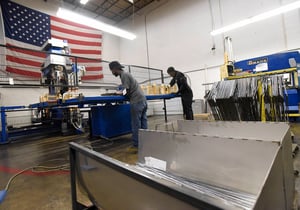 There are several kinds of welding techniques and processes that Marlin applies to its custom wire forms—the most common being arc welding processes (like MIG welding and TIG welding) and resistance welding. While both processes involve the use of electricity to help join two pieces of metal, there are a couple of differences between the two.
There are several kinds of welding techniques and processes that Marlin applies to its custom wire forms—the most common being arc welding processes (like MIG welding and TIG welding) and resistance welding. While both processes involve the use of electricity to help join two pieces of metal, there are a couple of differences between the two.
For example, arc welding processes often use a filler material to join two workpieces together, while resistance welding does not. In resistance welding, pressure is a major factor in the completion of a weld, while arc welding doesn’t rely on this as much.
Like any other manufacturing process, resistance welding can, if handled incorrectly, result in defects in the final workpiece. However, despite the need for precise control of electricity, weld timing, and pressure, resistance welding remains Marlin’s preferred method for joining stainless steel workpieces together.
Why?
Because, despite the relative difficulty of the process, there are some key benefits for using resistance welding on stainless steel:
What is Resistance Welding?
Resistance welding is an electrical welding process where two workpieces are held together as a current is passed through them. The heat to join the workpieces is created by their resistance to the electrical current being passed through them.
By pressing the two workpieces together during the welding process, they can be joined permanently—though care needs to be taken with the amount of pressure applied and how the long the flow of electricity is maintained.
Resistance Welding Benefits
- Precise, Mess-Free Welds. A common issue with many welds that use filler materials is that the filler material can pop and splatter during the welding process—creating an unsightly sharp or burr that has to be smoothed out later. Resistance welding doesn’t use filler. So, when joining two pieces of stainless steel, there’s much less risk of weld spatter (as long as the welded joint isn’t drastically overheated).
- Faster Welding of Stainless Steel. One of the interesting things about stainless steel is that most formulations of it have a fairly high electrical resistance. Because resistance welding works by passing electricity through a material and generating heat by resistance, stainless steel tends to get up to weld temperature very quickly. This allows resistance welds to be completed incredibly fast—for example, Marlin’s IDEAL welding machine can complete a weld in two milliseconds (i.e. 2/1,000 of a second).
- Reduced Discoloration at the Weld Site. Because resistance welding can be so fast (when controlled with a medium-frequency direct current welding controller), the heat from the weld doesn’t have as much of a chance to spread. This minimizes the risk of burns and discoloration around the weld site.
- Elimination of Bowing. When a workpiece is kept hot for too long, it can start to lose shape, bowing around the site of the weld. So, another benefit of lightning-fast welding processes like resistance welding of stainless steel is that these deformities are largely eliminated—the metal doesn’t stay hot long enough to bow.
- No Need to Worry about Flux/Filler. Resistance welding doesn’t use filler material at all. Because of this, there’s no reason to worry about having to continuously supply filler, or to stop the machine to refill it. Additionally, resistance welding, unlike arc welding, doesn’t need shielding gases. This lack of dependence on consumable materials ensures that a resistance welding machine can operate at peak capacity all day without interruption.
Have questions about welding custom wire forms? Reach out to the Marlin Steel team to get answers. Marlin’s mechanical engineers have years of experience in helping manufacturers by designing the perfect custom metal forms for their needs.


.gif)


